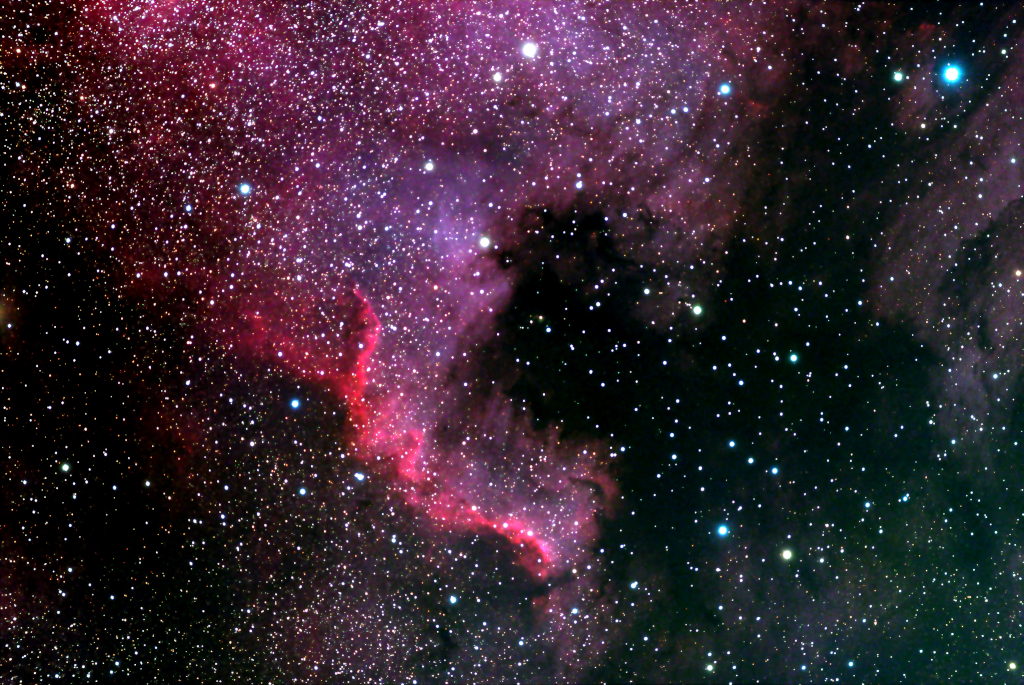Report by Dr. Gerold Holtkamp, November 19, 2024
Hardly anyone knows what Paradolia means, but everyone has them, especially every astronomer. It is a characteristic of us humans to recognize familiar objects or living beings in things or natural structures. The oldest examples are constellations. But today's astronomy is also full of them, even when gas nebulae or other structures in space that can only be seen with modern equipment are named. The North America Nebula is one such example, and right next to it is the Pelican Nebula. The scientific names are NGC 7000 and IC 5070 respectively.
I pointed my telescope at NGC 7000 on October 25th and 27th, 2024 and took the image below. The object actually looks like North America. The following will not be about its appearance, but rather some of the astrophysical properties of the nebula and the objects within it will be examined.

North America nebula and on the right in the image the “beak” of the Pelican Nebula, taken on October 25th and 27th, 2024
(when mouseover position of the sections described below)
Technical data:
Telescope APO 80/600, camera QHY268M, gain 60, offset 20, temperature -10° C,
Antlia filter, exposure time 68 min L, 34 min each R G B,
Mount AZ-EQ6,
Processed with AstroArt and Paintnet
The North America and Pelican Nebula belong to the same H-II-Region which is about 2600 light-years away from us and about 130 light-years wide [1]. They are only apparently separated to us on Earth by a large molecular cloud of cold, dense gas that forms the Gulf of Mexico and the Atlantic Ocean (pareidolia). H-II regions consist primarily of ionized hydrogen, which is stimulated to glow by strong radiation, especially UV light. Many young stars are formed in them.
For a long time, until the beginning of our century, it was not clear which star was suitable as a strong UV source. It had to be a young, very massive star. In fact, 2005 the quite inconspicuous star for us 2MASS J205551.25+435224.6 was identified as the most promising candidate. It was recognized as a star of spectral type O5V. So he's young, tall and very hot. If its light were not weakened by the above-mentioned dark cloud of magnitude 9.6, it would be almost as bright as Albireo for us [2]. In 2008, other possible additional candidates were suggested, but to date they have stuck with 2MASS J205551.25+435224.6 [3]. In 2016, another research group named it Bajamar, the old Spanish name for the Bahamas. In addition, the spectral type of this group was changed to O3.5 and a companion (type O8) was found [4]. Bajamar has another special feature. As young as he is, he should actually be surrounded by other young stars. Bajamar probably comes - in projection onto the sky background - from the “North Atlantic” region (pareidolia), from where it was ejected in a previously unknown event 1.6 million years ago. Such an event also occurred in the “Bermuda” area for other stars 1.6 and 1.5 million years ago. It is unclear what the possible cause is [5].

Bajamar can be clearly seen in my own image, as expected not as a blue star but as a reddish star because the molecular cloud in front of it not only weakens it but also changes its color. (See detail position in the overall photo when mouseover).
Another very interesting object is the one you can hardly see: L 935. This extensive dark molecular cloud mentioned above is home to large active areas in which new stars are formed. Here there are so-called Herbig-Haro-Objects. These are clouds of matter around young or nascent stars. Gas emitted from these collides with clouds of dust, causing the gas to glow. So it's not UV light from the star Bajamar that's causing the glow. However, these gas areas probably change within just a few thousand years [5].

Both some Herbig-Haro objects and two of the young stars mentioned above – LkHα 188 and LkHα 189 – can be clearly seen in the enlarged section of my image (see section position in the overall image when mouseover). A brightness outburst of four magnitudes was measured at LkHα 188 in 2010, which shows that this star has not yet reached a stable phase of its life [6].
The North America Nebula is home to many more interesting objects than described here. This article is simply intended to show which details can already be seen in photographs taken from an urban observation point, even using amateur means. The amount of detail in the sky above us is almost limitless.
________________________________________________________________________
[1] The Formation of a Stellar Association in the NGC 7000/IC 5070 Complex: Results from Kinematic Analysis of Stars and Gas
Michael A. Kuhn et al, The Astrophysical Journal, 899:128 (30pp), 2020 August 20 https://iopscience.iop.org/article/10.3847/1538-4357/aba19a
[2] The ionizing star of the North America and Pelican nebulae
F. Comerón and A. Pasquali, Astronomy & Astrophysics, Volume 430, Number 2, February I 2005
https://www.aanda.org/articles/aa/abs/2005/05/aa1788/aa1788.html
]3] O-like stars in the direction oft the Northamerica and Pelican Nebulae
Straižys, V. & Laugalys, V. Baltic Astronomy, Vol. 17, p. 143-159
https://articles.adsabs.harvard.edu/pdf/2008BaltA..17..143S
[4] THE GALACTIC O-STAR SPECTROSCOPIC SURVEY (GOSSS). III. 142 ADDITIONAL O-TYPE SYSTEMS
J. Maíz Apellániz et al, The Astrophysical Journal Supplement Series, 224:4 (42pp), 2016 May
https://iopscience.iop.org/article/10.3847/0067-0049/224/1/4/pdf
[5] Star formation in the “Gulf of Mexico”
T. Armond et al, Astronomy & Astrophysics, Volume 528, April 2011, A125
https://www.aanda.org/articles/aa/full_html/2011/04/aa12671-09/aa12671-09.html#R21
[6] The large amplitude outburst of the young star HBC 722 in NGC 7000/IC 5070, a new FU Orionis candidate
E. H. Semkov et al, Astronomy & Astrophysics, Volume 523, L3 (2010)
https://www.aanda.org/articles/aa/pdf/2010/15/aa15902-10.pdf